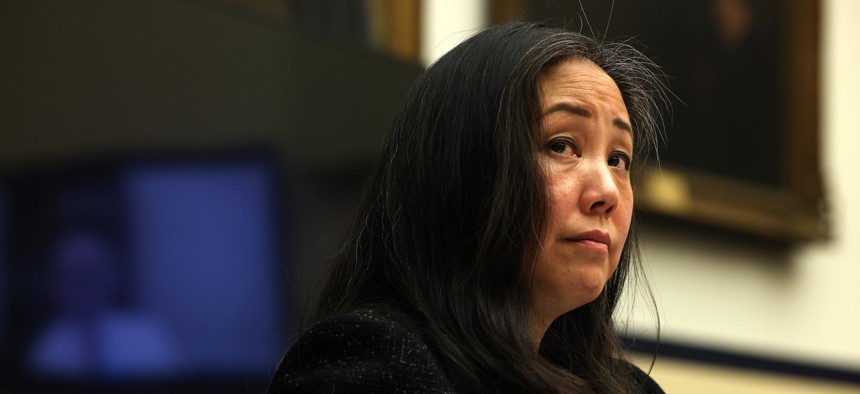
Mieke Eoyang, Deputy Assistant Secretary of Defense for Cyber Policy, testified at a hearing of a House Armed Services subcommittee on May 14, 2021. Anna Moneymaker/Getty Images
Digital Authoritarianism is a National Security Threat, Pentagon Cyber Leader Says
The U.S. must fund the development of technology that can compete with the offerings of authoritarian countries, said Mieke Eoyang, deputy assistant defense secretary for cyber policy.
A top cyber official at the Defense Department called digital authoritarianism a threat to national security and said the U.S. must invest in partnerships and development of indigenous technology alternatives.
The U.S national security enterprise is moving its focus away from countering terrorism and toward competition with so-called great power or near peer adversaries. With China rising to the fore as a “pacing threat” for the U.S., its status as a state that relies on surveillance of its own people is drawing scrutiny over the national security risks posed by digital authoritarianism.
Digital authoritarianism is a term that describes regimes that use technology to control and repress their populations. While China is certainly not the only purveyor of digital authoritarianism, it is certainly the largest.
At Defense One’s Tech Summit event Thursday, Mieke Eoyang, deputy assistant defense secretary for cyber policy, explained how digital authoritarianism poses a threat to national security, and what the Defense Department can do about it. Eoyang described digital authoritarianism as contrary to the values those at DOD are sworn to defend.
It "really poses a national security challenge to us in the United States. It closes space. It makes it more dangerous for Americans who may choose to speak out against what they see as human rights abuses in other countries,” Eoyang said.
“And so that, you know, that goes against our core values inside the U.S., and also it represents a…competitive challenge to U.S. technology companies when we see countries like China exporting this technology all around the world. With their technology it’s not just neutral, it does come with the ability to engage in this kind of digital repression,” she said. “So we see this as a challenge to the department, our operations and our values.”
To combat this threat, Eoyang said, the U.S. needs to fund indigenous technology alternatives. She highlighted DOD’s investments in bolstering research and development as well as manufacturing: In the rollout of President Joe Biden’s first budget proposal, Pentagon officials touted a proposed $112 billion investment in research, development, test and evaluation as the largest-ever.
The request also proposes $2.3 billion for microelectronics, a sector critical to the digital authoritarianism and competition with China conversations because the U.S. lacks a robust manufacturing base and is largely reliant on the Taiwan Semiconductor Manufacturing Co., more commonly known as TSMC, for such technology.
There are several ongoing efforts at DOD and in Congress that touch on the problem of digital authoritarianism. The Defense Advanced Research Projects Agency recently put out a call for artificial intelligence research proposals that can help foster a better understanding of how digital authoritarianism works. The Senate also passed the U.S. Innovation and Competition Act, formerly known as the Endless Frontier Act, which includes billions to boost efforts to reshore microelectronics manufacturing. Following passage of that legislation, a prominent technology think tank called on Congress to establish an independent agency to drive a national technology strategy in order to compete with China effectively.
Sen. Mark Warner, D-Va., who championed the Creating Helpful Incentives to Produce Semiconductors for America Act, also introduced legislation in March that aims to counter the influence of authoritarian nations such as China on emerging technologies by creating an international partnership led by a new State Department office. The new office would focus on setting international technology standards.
This kind of robust collaboration with allies is an important piece of countering digital authoritarianism, Eoyang said.
“I think that we need to make sure that we are offering alternatives to allies when they are thinking, when they are considering their own technology purchases, and we need to do a better job of sharing the risks and vulnerabilities that our allies and partners might incur if they were to engage in purchasing such technologies,” she said.




